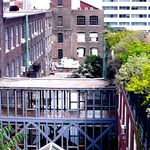From the Globe:
VISUAL ARTS: THE ART GALLERY OF ONTARIO REBUILD
Getting the hang of it
As the AGO prepares for its fall reopening, curators face a crucial question: How do you deploy your collection in the new space to best tell the story of art? Sarah Milroy reports
SARAH MILROY
July 19, 2008
New museum buildings have a way of hogging the spotlight, with the great unveiling of the architect's vision overshadowing the real point of it all: the art, and how it is installed in the new spaces.
But the Art Gallery of Ontario's director Matthew Teitelbaum likes to think about art - more, perhaps, than is customary in museum directors these days, who tend to preoccupy themselves almost exclusively with fundraising and the challenges of management. In fact, as his Toronto museum's $254-million overhaul by renowned Los Angeles architect Frank Gehry nears completion, he knows every inch of the reinstallation by heart and he walks me through the plans with the slightly anxious air of a mathematician unveiling an as-yet-unproved theorem.
Is it appropriate, though, for a director - even one who was formerly a curator, as is the case with Teitelbaum - to get his hands dirty in curatorial affairs? "I think so, absolutely," he says, as we conclude a tour of the miniature models of the galleries and the works of art they will contain. These days, they are set up in a working space near the museum's gallery school, a kind of backstage laboratory for the still ongoing discussions about the collection, and how best to deploy it.
"This is how we deliver on the promise. We have to provide a great experience of looking at art," Teitelbaum says. "Otherwise, why have we put people through all of this?"
The suite of cardboard models are filled with Lilliputian mini-replicas of the AGO's prime works of art, and they reflect the results of hundreds of hours of curatorial collaboration, conflict and, finally, consensus between him and his curators, headed up by Dennis Reid, director of collections and research, and the gallery's new director of exhibitions and publications, Catherine de Zegher. Upstairs, in the new contemporary art tower and in some of the European galleries below, the real process of moving art into the galleries is well under way.
There are some complexities. For example: How to keep the multifaceted Kenneth Thomson gift intact as a physical entity (it includes ship models, important Canadian paintings, medieval ivories and miniature boxwood carvings) while still integrating it into the narrative of art history that is the collection as a whole? And how to exploit areas of strength in the collection without lending undue weight to relatively minor historical players? In other words: How do you tell the story of art working with what you've got?
It can be tricky. "For better or worse, we have the biggest collection of Robert Motherwell works on paper in the world," says Teitelbaum, offering an example. "I happen to think it's for the good."
In the new galleries, Motherwell will have a space of his own, reflecting this area of the museum's strength, and the installation will include two major large-scale canvases by the American abstract expressionist.
But Motherwell will be showcased not solely thanks to the scale of his accomplishment, which is relatively minor compared with many of his contemporaries that one could name. Rather, in this collection, his works allow the curators to tell a story about artistic influence and art's relationship to its historical moment. Motherwell will be positioned between the galleries devoted to European surrealism (a strength of the AGO's holdings) and those focusing on British modernist sculpture (another area of richness), rightly presenting him as a seminal carrier of ideas between continental Europe and the world beyond, a world freshly traumatized by war.
In this last gallery, the curators are presenting a 1976 film projection of an atomic blast by contemporary artist Bruce Conner.
"The focus here is not just on the question: Where does abstract expressionism come from as a style in art, or as a point in the continuum of art history," says Teitelbaum. "Instead, the focus is on: How does it express a moment in time? What factors are involved in the creation of an artistic style?"
Abstract expressionism, he adds, speaks of "the impossibility of image making, and the need for a raw expression of horror and degradation." A small bronze depicting a grieving woman's face and hands, made in 1938 by the German expressionist Kathe Kollwitz, will be positioned near the great Motherwell canvases, its presence aiming to underscore the humanitarian crisis of the era.
This will be one of the most striking aspects of the AGO re-hang - the coupling of works of art from different periods, or different cultures - and it will be a gamble, either having the liveliness and surprise of an ingenious salad, lightly tossed, or the disarray of a dog's breakfast. Like the thematic installations of art at London's Tate Modern (which have been both praised for making art accessible and reviled for quelling art's complexity), success will depend entirely on how the objects interact with each other in real space, and that can be hard to predict. The possibilities, though, are intriguing.
One dramatically sky-lit gallery designed by Gehry to house the Arctic landscapes of Lawren Harris will also showcase three of the masterpieces of Northwest Coast aboriginal art from the Dundas Collection, acquired for the AGO by patron David Thomson last year.
Another gallery, featuring work by the contemporary Montreal artist Betty Goodwin, will include an Inuit carving of a ghost figure in bone, an object made 10,000 years ago - a juxtaposition aimed at highlighting and refining Goodwin's theme of memory and loss.
A third space pairs a rough-hewn landscape by London, Ont., painter Paterson Ewen with a 19th-century buffalo hide inscribed by an unknown Crow artist, the combination suggesting two culturally divergent ideas of landscape, and art's capacity to embody a sense of place and belonging.
One of the most striking of these dramatic moments is likely to be the adjacency of the newly acquired marble crucifixion titled Corpus (1655) by the Italian baroque artist Bernini and a contemporary sculptural installation by Canadian artist David Altmejd. Altmejd's work will be displayed next door to Bernini's in a space flanking the Grange. With more than 300 years between them, these artists have both produced spectacular evocations of the male body, charged with sensuality and decadence. Both also portray the male form in the throes of mystical transformation. How will the two artists come to reveal each other?
The design of the contemporary galleries also allows for smaller spaces in which the curators can single out particular artistic careers for consideration, a strategy that implies an artist-centred view, holding up the importance of the singular accomplishment and vision.
These little incubators will allow for more intense, up-close confrontations with key figures, among them Michael Snow, Robert Smithson, Jack Chambers, Gerhard Richter and the artist collectives N.E. Thing Company and General Idea. (Nearly 30 per cent of the contemporary work on display will be new acquisitions.) Throughout these galleries, the emphasis will be on chronology, with contemporaneous but stylistically divergent objects rubbing shoulders, works that would normally not be seen out in public together.
In one gallery, for example, a political painting from 1967 by African-American artist Faith Ringgold, from her series titled The American People, will be installed next to the museum's magisterial Donald Judd stack piece, which was made the following year - a minimalist icon in reflective metal and tinted glass. Both can be considered works of political art, but they operate in very different ways. Together, it is hoped they will deliver a snapshot in time, jumping the ruts of art-historical classification.
One of Teitelbaum's favourite examples of this will occur on a fourth-floor landing, where visitors will be greeted by an Alexander Calder mobile overhead and beneath it three small sculptures on pedestals dating from the period 1960-62: one by British modernist Barbara Hepworth, the second by French-American sculptor Louise Bourgeois and the third by the Inuit artist Louise Anguatsiark Tungilik.
"These women were not in dialogue at the time," Teitelbaum says, "but they can be now." Museums are blessed with the gift of hindsight, this installation implies. They should use it creatively.
Toronto's Art Gallery of Ontario re-opens to the public on Nov. 14.
http://www.theglobeandmail.com/serv...9.AGO19/TPStory/?query=art+gallery+of+ontario
AoD




